So I tend to get a touch peeved when I’m reading a book and characters entering an environment of wealth and class are not reacted to in a manner that is coherent to how wealth and class works. This is largely when characters enter situations where a majority of the people in the room are upper class, especially when a large portion are termed “old money”. Now while this trend has been more common in works centering in the modern day, I want to emphasize something real quick:
The basic politics of the upper class have remained largely unchanged for the last 100 or so years. The concepts of old money, new money, gentry, hierarchy, and old money views on caste, mental illness, and race have been, by and large, untouched since about the 1920s. Because this is a lengthy and very uncomfortable topic to discuss (among other things, this entry will touch on racism, classism, homophobia, transphobia, and ableism), I encourage futher reading on the subject. Like all social groups, people in these social circles tend to vary in personality and tolerance so as a disclaimer: this does not apply to all members of the upper class.
As a further disclaimer, this only applies to western upper class structures, particularly the de facto aristocracy of the US and the existing structure in the UK.
For this overview, because it is easiest for me and I think is very helpful as an example using something familiar, I’m going to use Batman characters in a particular verse I write as an example. Because this is a personal verse I will be using personal alterations, when they become relevant, I will bring them up.
Now in general when I think of upper class structure I split it into three groups, though two are essentially the same thing: old money, new money, and gentry. Old money and gentry are roughly the same thing, but in the case of, say, the characters I’m talking about, gentry applies in a different way than old money. Jonathan Crane is gentry, Pamela Isley is old money, more on that in a second.
Firstly, the difference between old money and new money. Old money, as a general term, is an upper class family that has been upper class for multiple generations, new money is not. Pamela Isley applies as old money because her family is wealthy and has been for many years. Another DC character this can apply to is Hartley Rathaway, AKA the Pied Piper from the Flash. The Rathaways are old money. The Waynes, by comparison, are new money, Wayne Industries/WayneTech is not an old company and Bruce’s wealth, while inherited, is only one or two generations removed, and thus is regarded as new money.
Now as for the difference between gentry and old money. While in a sense gentry essentially IS old money, it is more of a class term than a wealth term, it applies to born social standing, and usually applies more heavily to the UK and the South. Manor houses still owned by the families from the 1910s and 1920s are generally houses belonging to gentry. This is why I specify Jonathan Crane as being gentry as opposed to old money. The Keeny family, Jon’s maternal side, most certainly is gentry, as Keeny manor is an old plantation house in Georgia and his relatives, particularly his grandmother Mary and great grandmother Marion, are very conscious of reputation.
Which brings me to the big elephant in the room, gentry, old money, and their opinions on…let’s go with deviance. That’s a good blanket term. Now as it tends to go, new money does not have these problems, and keep in mind I said “tends”, there most certainly are people who are new money and have these habits, and gentry as a whole is much worse than old money so prepare to get extremely uncomfortable and disappointed in humanity because it is soul crushing.
So because what’s canon in the comics is a little more important I’m going to start with disownment, which is something old money and gentry still does, yes, in 2017, they’re still disowning their kids. Now in the comics, and the CW Flash keeps this, Hartley Rathaway is confirmed to be disowned by his parents because of his sexuality (for those unfamiliar with it, Hartley is gay). In the verse I tend to write, Pamela Isley is either bisexual or a lesbian (I have not figured it out myself but I am leaning towards lesbian), and therefore her family has also disowned her. Karen Keeny, Jonathan Crane’s mother, was disowned by the rest of the Keeny family after a sexual relationship with Gerald Crane, Jonathan’s father, which yes, resulted in Jonathan. Anything done by a child of gentry or old money that could potentially result in a family’s tarnished reputation usually results in either the child being ostracized or disowned outright.
Jonathan is something a little more complicated because, particularly in this verse I’m discussing, a double-edged sword. In the verse I tend to write, Jonathan is not only illegitimate, he’s mixed race, his father’s side of the family is Crow Native American (and yes, haha, great pun, it was a total accident so hush), meaning Jonathan is half-white, half-Native American. Now by and large, most children who are mixed race in some respect are not always disowned, though occasionally they are but what I’m going to focus on how mixed race and illegitimate children are regarded, particularly in gentry, when they are “kept”. Now keep in mind a child that is mixed race is usually illegitimate, hence the heavy overlap in treatment, and while there is such a thing as white-passing in biracial or other mixed race children, whether the child “passes” or not is not up to a layman. In this verse, from a layman, or non-gentry, point of view, Jonathan passes, by the unbelievably high standards of the gentry, he does not.
Now by and large, I’m going to summarize this because, to be very frank it is much easier to explore in works of fiction than explain, but in a sense these children sort of occupy a halfway point between disowned and gentry. They are, in all circumstances, treated as equal in the sense that they are given similar, if not identical educations and treatment, but, by and large, do not belong. Bringing up Jonathan again and comparing him to Hartley, Hartley was not on bad standing with his parents until he came out, Jonathan was always on bad standing with his great grandmother and guardian, Marion Keeny, but Marion Keeny, instead of throwing Jonathan out with her granddaughter, raised him and taught him the same social graces that Hartley was taught. Hartley and Jonathan can both navigate high society with roughly the same level of competency, but as his sexuality is largely a family secret, he is not treated differently in comparison to Jonathan. As an added note, Southern gentry and more Northern old money tend to be similar about “keeping” a mixed race or illegitimate child in that it’s kind of viewed in the same regard as adopting a non-white child. It’s regarded in more of an “act of charity” sense or an “act of mercy” sense. And yes this does sometimes to place the child in a situation where their guardian/parent is emotionally manipulative or straight-up abusive, but that is a little less common modernly. It is the case with Jonathan however, as Marion Keeny is from the gentry in the 1920s and 30s and is therefore a lot less tolerant (sorry did I say less tolerant? I meant more racist) than old money/gentry is/is trying to be.
As for actually further reading on these regards, I’d recommend, firstly, any book where class plays a major theme. My particular go-to book tends to be The Great Gatsby. And while, yes, it does take place in the 1920s, a lot of the attitude of the Buchanans and Carraways is still a decent reflection of modern old money and gentry attitudes towards basically everything (looking at Tom Buchanan’s “Nordic rant”). It is…outdated, but only in some sense. Other readings I can think of lean closer to sociological studies. All in all, this is largely from my own personal research and could have my own personal biases slapped on. The basic consensus I’m getting at is this:
Old money and gentry are exclusive and homogeneous, deviance is discouraged within the group, so outsiders are regarded with hostility.
This needs to be kept in mind when writing characters walking into that sort of situation from the outside. The message will be made clear: you do not belong, and it should probably be written accordingly.
















